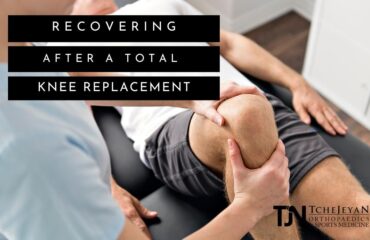Your knee may be causing you pain; you may be intensely suffering from arthritis in your joints – but when should you decide to go ahead and have joint replacement surgery?
Many patients put up with joint pain longer than necessary, but most surgeons will suggest not waiting until you reach a point of unbearable pain. At TJN Orthopedics, board-certified Dr. Gregory H. Tchejeyan uses 3 criteria to determine if someone is a candidate for joint replacement surgery. He prepared an entire article explaining the decision process behind determining when to have knee surgery for arthritis here.
Compartmental Knee Pain
Candidates for joint replacement surgery often have knee pain that is confined to one general area, or compartment – of the knee. This can be caused by many factors – but most commonly, confined knee pain is the result of a preexisting injury that is rearing its ugly head.
This pain warrants either UKA (Unicompartmental Knee Arthroplasty) or TKA (Total Knee Arthroplasty). According to Dr. Tchejeyan, for many patients, it’s either UKA now, or TKA later!
Correctable Deformity
Arthritis, or painful inflammation or stiffness in the joint, is progressive, meaning it worsens with time and age. This can result in a reduction of cartilage, causing bone-on-bone arthritic pain. An x-ray would clearly indicate a patient’s candidacy for knee replacement surgery, as long as the nearby ligaments are intact and the deformity is correctable.
Correctable deformity refers to the concept that an arthritic knee, over time, develops a deformity that causes it to be out of alignment. Oftentimes, a slight bow will develop that needs to be corrected in surgery. A partial knee replacement places material between bones to allow for better movement, but alignment is an equally important factor in reducing pain. With intact surrounding ligaments, the surgeon can manually shift the bone during surgery to correct the joint’s alignment as long as the deformity is not too advanced.
Delaying The Inevitable
As we age, our ligaments break down, and the chances of our bones developing further erosion and deformity increases. If patients wait too long, this can preclude them from having a partial knee replacement. The progression of the deformity may become too severe for a partial knee replacement, and a total knee arthroplasty will be required instead.
“A partial knee replacement can potentially last 20-30 years and offer a pain-free existence during a time of life when people are most active. My patients in their 50’s and 60’s are ready to enjoy the fruits of their labors in life – they want to remain active! To delay surgery and ‘deal’ with pain not only inhibits their day-to-day mobility, but it could also mean that the deformity progresses to a point where required surgery would become more intense – and at an older age, when recovery is often more difficult.”
-Dr. Gregory H Tchejeyan
Whether a patient needs a partial or total knee replacement, Dr. T. always notices one commonality – they always admit they should have done it sooner!
Getting Ahead Of The Pain
As long as a patient meets the criteria of x-ray findings, has a correctable deformity, and is seeking relief from regular joint pain, then there is no reason to wait for the full knee replacement. Surgeries done earlier in the disease progression are less intense and usually offer a more effective outcome.
Even Dr. T’s older patients, however, do undergo successful joint replacement surgeries despite their advanced age or conditions. With every decade, the chance of undergoing only a partial knee replacement decreases, but it is still possible. Dr. Tchejeyan’s best advice is to not wait until you’re no longer a candidate, but stay informed and aware of your personal situation, together with your surgeon.
If you’re experiencing debilitating joint pain now, you should:
- Get evaluated by an orthopedist early in the process
- Formulate a plan with your surgeon
- Consider getting regular x-rays to check the progression of your condition
- Be honest with yourself!
- Make a decision early enough in your pain process in order to maximize your ability to function well and pain-free!
There’s rarely a reason to delay your surgery. If you’re experiencing joint pain that interferes with your day-to-day activities, reach out to TJN Orthopedics. Our friendly staff welcomes the opportunity to get to know you. Contact our office today to schedule a consultation with the “LA Knee Guy”, Dr. Gregory H. Tchejeyan.




[…] moderately, you might not need a hip or shoulder replacement until you are in your 80s. It’s never too late to repair your joints and restore your range of movement. In fact, this can be a great way to […]